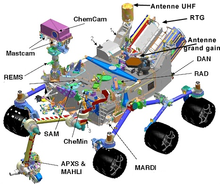Friday, August 3, 2012
Saturday, June 23, 2012
Voyager 1 At The Final Frontier
At the edge of the solar system, Voyager 1 is reporting a sharp increase in cosmic rays that could herald the spacecraft's long-awaited entry into interstellar space.
Credit: Science@NASA
Link to the NES Virtual Campus home page.
In the early 2000s many new, relatively large planetary bodies were found beyond what was at the time planet Pluto, and with orbits extending hundreds of AU out past the heliosheath (90-1000 AU).
The NASA probe New Horizons may explore this area after it performs its planned Pluto flyby in 2015 (Pluto ranges from about 29-49 AU). Some of these large objects past Pluto include, Eris (136199), Haumea (136108), Makemake (136472), and Sedna (90377). Sedna comes as close as 76 AU, but travels out as far as 961 AU at aphelion, and minor planet 87269 goes out past 1060 AU at aphelion. Bodies like these have an impact on how the Solar System is understood, and traverse an area previously only in the domain of interstellar missions or precursors probes.
After the discoveries, the area is also in the domain of interplanetary probes; some of the discovered bodies may become targets for exploration missions,an example of which is preliminary work on a probe to Haumea (136108) and its moons (at 35-51 AU). Probe mass, power source, and propulsion systems are key technology areas for this type of mission.
Read more CLICK HERE
Tuesday, May 1, 2012
Hi this is Johnny Wheelock

Source: Hubblesite.org
I love the Hubble website I get such joy looking at the universe and all the Galaxies !

Source: Hubblesite.org
Government Organization
Hubble captures images of cosmic wonders and sheds light on many of astronomy's greatest mysteries. For more, visit http://hubblesite.org/ like us on FaceBookWednesday, March 14, 2012
Hubble press releases:
- Hubble's Deepest View of the Universe Unveils Bewildering Galaxies across Billions of Years
- Hubble's Deepest View Ever of the Universe Unveils Earliest Galaxies
- Hubble Approaches the Final Frontier: The Dawn of Galaxies
- The "Undiscovered Country" of Primeval Galaxies
- In Deep Galaxy Surveys, Astronomers Get a Boost — from Gravity
Notes
- In the show description above, I paraphrase "a long, long time ago in a galaxy far, far away," which is, of course, from the opening of the movie "Star Wars." It serves as a nice touchstone for the public that is, coincidentally, scientifically accurate. If a galaxy is far, far away, then any news we have about it could only be from long, long ago. In fact, given the large spiral galaxy shown in one of the ending shots of "The Empire Strikes Back" (a shot that is definitely NOT scientifically accurate), the adventures of Luke, Han, and Leia must have taken place at least several million years ago. But I doubt George Lucas knew his opening line was scientifically correct. After all, he didn't know that a "parsec" is a unit of distance, not time.
- The initial press release for the Hubble Deep Field (HDF) in January 1996 states that the image contains "at least 1,500 galaxies." This number was the result of rather quick image processing and analysis, as the observations had only been completed about two weeks prior. Later, improved study revealed the number of objects in the HDF to be closer to 3,000. Why the rush? The American Astronomical Society (AAS) holds their winter meeting &mdash one of the best events at which to publicize a major result &mdash each January. Also, the HDF data was shared immediately with the entire astronomical community, and the AAS meeting was the perfect time to get the word out.
- The concept of "out in space equals back in time" is a fundamental part of thinking like an astronomer. It can, however, lead to some confusion in dating events like supernova explosions. Supernova 1987A was observed on Earth in 1987, but, since the explosion took place in the Large Magellanic Cloud (LMC), the event really occurred about 170,000 years earlier. One tries to be careful to differentiate between the date it was observed and the date it exploded, but it is easy to slip. Just think, if supernovae occur about once a century, there are about 1700 stellar explosions that have already occurred in the LMC, but which we have yet to see. Going further, most of the major astronomical discoveries of the rest of our lives have already happened, and astronomers are just waiting for the light from those distant objects to reach us. That's thinking in terms of space-time.
- Here at STScI, we produced an IMAX short film called "Hubble: Galaxies Across Space and Time."The film explores the Great Observatories Origins Deep Survey (GOODS) and highlights the changes in galaxy shapes with distance, and therefore time. The film features a journey into the GOODS image with all the galaxies placed at their correct relative distances based upon their measured redshifts. One thing to note is that the distances in the film are compressed by a factor of several hundred to make a better film shot, but otherwise the visuals are all Hubble data. We created a similar journey into the Hubble Ultra Deep Field for the IMAX film "Hubble 3D."
Sunday, January 8, 2012
Sharing What Hubble Is All About
http://hubblesite.org/hubble_discoveries/discovering_planets_beyond/
I love YouTube and here is a collection from my favorite site please watch
Subscribe to:
Comments (Atom)
